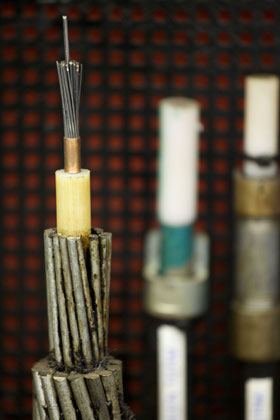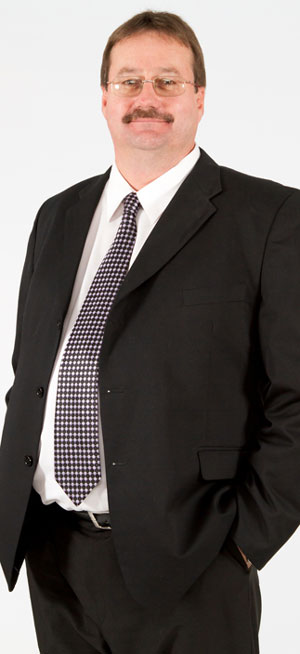
The West African Cable System (Wacs), the highest-capacity undersea telecommunications cable to land in SA to date, will eventually offer countries along its route, including SA, up to 5,1Tbit/s of capacity into Europe.
With 14 entities involved in the consortium that made the US$650m, 14 500km-long cable a reality, the biggest challenges have been red tape, regional variables and the technical challenges of laying the physical cable.
The cable weighs as much as 20 Airbus A380 aircraft and at its deepest point it lies 5,1km below the surface of the Atlantic Ocean. And were one to attach all of the fibre pairs end-to-end, they’d circle the globe three times.
But there’s another important aspect to the cable: powering it. This is done via 10,5kV direct-current to drive the repeaters. The cable is powered from every landing station and every branch along its route from London to its final destination at Yzerfontein, north of Cape Town.
Years in the making
Johan Meyer, Telkom’s executive for global capacity, has been involved in one way or another with almost every cable system that has landed in SA in modern times. He says any project of the scale of Wacs takes at least two to three years to complete and anyone claiming they can roll out a cable in less time is “delusional”.
Work on Wacs began in April 2009, with the contracts for its use coming into force by the end of May 2012. Considering the amount of planning and the number of stakeholders involved, Meyer says this is a respectable timeline, even if the cable was originally meant to go live last year.
He says a cable project has three cycles: development, where an interim management committee is appointed and contractual details are outlined; an implementation phase that includes committees handling everything from the financial aspects to operations and maintenance planning; and finally the operational phase that runs for the lifespan of the cable.
Wacs is expected to be operational for 20 to 25 years, during which time many of the same committees — with the exception of the one responsible for procurement — continue their work. At first, the cable will offer “only” 500Gbit/s, but Meyer says the first upgrades — which operators can institute individually — are expected in the next two years.

Sat-2, the first fibre-optic cable to land in SA, is almost 20 years old and is fast approaching retirement. “Amazingly, it has lower latency than Wacs,” says Meyer. However, Sat-2 offers only 1Gbps — a straw compared to the fire hydrant that is Wacs.
Despite the enormous capacity of Wacs, Meyer says the maintenance costs of Sat-2 are almost the same and this is partly why a cable’s lifespan is seldom extended: by the time they’re two decades old, technology has advanced so far it’s economically impractical to keep maintaining them.
At $650m, Wacs has cost more than double the roughly $300m in costs Sat-2 incurred. However, allowing for inflation over the period and the hugely increased capacity Wacs offers, the motivation for retiring Sat-2 becomes clear.
Despite their costs, undersea cables are highly vulnerable. Earthquakes are a big problem. And in shallow waters, especially, they can be damaged by fishing, ships’ anchors, trawling and, until recently, by shark bites. Meyer says more modern cables are insulated to minimise the electromagnetic fields around them. The fields appeared to attract sharks.
The art of negotiation
Of course, dealing with natural phenomena is only part of the equation of building and managing a subsea cable system. Arguably the bigger challenge is dealing with bureaucracy and the demands of a diverse range of stakeholders.
“It’s a matter of give and take getting a consortium project off the ground,” Meyer explains. “This is where the committee chairs play a role. They facilitate a position and bring a package of decisions together that benefits different players, but that collectively benefits all of them. Operators have to work together to reach a cost-effective solution and to ensure that no one can control any other company’s abilities.”
Angus Hay, co-chair of the Wacs management committee and GM of strategic business development at Neotel, echoes this sentiment. “No two consortia are the same and one of the things that’s been refreshing about Wacs has been the willingness of parties to get the thing done. There hasn’t been much politicking going on.”
Hay says the big SA players have been keen to keep the project moving. “The biggest challenges have been with licensing, physical implementation, permitting and the like. Those have been the real hurdles. There haven’t really been hurdles from the parties involved.”
John Thomas, Telkom senior manager for core network operations, says that in SA’s context the process has required extensive environmental impact assessments and “getting affected parties on board up front”.
“We engaged the fisheries right at the start and did impact assessments on their fishing groups. At the landing site in Yzerfontein we engaged with the mayor and the people around the design of the land route,” says Thomas. “The more open we became with it the easier it was.”
Thomas says the project was completed in record time with construction teams working in “24-hour operational cycles”. — (c) 2012 NewsCentral Media

